
Indiana Woman Arrested After Traveling To DC To Kidnap And Assassinate Trump

A Disturbing Convergence of Radicalization and Violence
The recent arrest of Nathalie Rose Jones, a 50-year-old woman from Indiana accused of traveling to Washington, D.C., with the intent to kidnap and assassinate former President Donald Trump, has thrown a harsh spotlight on a troubling reality: the dangerous intersection of online radicalization, personal grievances, and the normalization of violent political rhetoric.
Federal authorities say Jones’ threats — posted repeatedly across social media and later confirmed in direct conversations with agents — went far beyond idle talk. Her story, though singular in its specifics, is emblematic of a much deeper crisis in American public life, where toxic digital echo chambers, untreated psychological distress, and sharp political polarization can collide to deadly effect.
This case is not only about one woman’s descent into extremism; it raises urgent questions about the fragile line between constitutionally protected speech and actionable threats, and how institutions can better prevent words from escalating into violence.
The Arrest and the Allegations
Federal prosecutors charged Jones, a Lafayette, Indiana resident, after she allegedly escalated from posting violent threats online to traveling to Washington, D.C., with the stated goal of kidnapping and killing Donald Trump. Authorities began monitoring her activity in early August after a series of increasingly explicit posts drew attention.
In one now-documented threat, she wrote that she was prepared to “sacrificially kill this POTUS by disemboweling him and cutting out his trachea,” a chilling statement that also referenced former Congresswoman Liz Cheney and an obscure phrase she called “The Affirmation.” Days later, she doubled down, urging Defense Secretary Pete Hegseth to orchestrate what she described as an “arrest and removal ceremony” at the White House, specifying both a date and time.
The specificity of her language and planning triggered alarm bells. The U.S. Secret Service quickly intervened, and during questioning, Jones allegedly admitted she would attempt to kill Trump “if the opportunity presented itself,” even describing her plan to use a bladed weapon. She framed her motives as a form of “justice,” claiming she sought to avenge the countless lives lost during the COVID-19 pandemic, calling Trump both a “terrorist” and a “nazi.”
Although she later attempted to walk back her statements, claiming she no longer intended harm, investigators noted that her threats were specific, repeated, and matched by real-world actions, including her attendance at a protest near the White House shortly before her arrest.
Jones now faces multiple federal charges, including transmitting threats across state lines and threatening to kidnap or kill the president — crimes that carry severe penalties. U.S. Attorney Jeanine Pirro emphasized the gravity of the case:
“Threatening the life of a president or former president is one of the most serious federal offenses. It will always be met with swift and decisive prosecution.”
A Broader Pattern of Escalating Threats
While Jones’ case is striking, it is far from an isolated incident. Threats against public officials have surged nationwide in recent years. According to the U.S. Capitol Police, threatening communications to members of Congress nearly doubled between 2017 and 2021, prompting the creation of specialized assessment teams to handle the caseload. The Secret Service now juggles thousands of similar investigations each year, ranging from casual online remarks to coordinated assassination plots.
Experts point to a toxic mix fueling this surge: extreme political polarization, disinformation campaigns, and the amplification effect of digital platforms where anger and conspiracy theories spread unchecked. The January 6 Capitol attack remains the most vivid example of how incendiary language and online organization can rapidly escalate into coordinated violence.
More recent incidents — from the brutal 2022 hammer attack on Paul Pelosi, the husband of former House Speaker Nancy Pelosi, to threats against election officials nationwide — highlight how public figures and their families are increasingly vulnerable. Jones’ arrest fits this dangerous pattern: one individual, isolated but empowered by the internet, translating rhetoric into intent.
Legally, prosecutors have also refined their approach. Courts have consistently upheld that a “true threat” — one expressing a serious intent to commit violence — is not protected speech. In Jones’ case, her detailed posts specifying methods, dates, and targets fall squarely within that definition, underscoring why federal authorities acted so quickly.
The Digital Amplifier of Extremism
Jones’ journey into extremism illustrates the powerful role that social media plays in radicalization. Platforms like Facebook, X, and fringe forums provide not only an outlet for grievances but also an echo chamber where violent fantasies are validated and intensified.
Researchers note that online spaces often blur the line between venting and planning. Jones repeatedly used her Facebook page to broadcast violent ideation, transforming her private anger into a public narrative. For investigators, the turning point came when her posts shifted from abstract rage to actionable intent — with a date, place, and explicit plan.
This case also underscores a critical dilemma: how to balance free expression with public safety. Civil liberties advocates warn of the dangers of overreach and mass surveillance, yet the Jones incident demonstrates the catastrophic risk of underestimating credible threats. It raises pressing questions about whether platforms should bear more responsibility for monitoring and reporting violent rhetoric before it metastasizes into real-world violence.
Psychological and Ideological Drivers
While technology provided the stage, Jones’ words reveal deeper psychological and ideological forces at play. She told agents she viewed Trump as a “terrorist” responsible for pandemic deaths, framing her intent to kill as a sacrificial act of justice. Experts in political violence say such framing is common: personal trauma and anger often merge with extremist ideology to create a narrative where violence feels righteous, even inevitable.
Her references to “sacrificial killing” and vague, symbolic phrases like “the compound” suggest she was operating in a psychological space where violence became ritualized — an act of distorted morality rather than mere aggression.
Mental health professionals caution that individuals who pose such threats are often in crisis long before law enforcement intervenes. Consistent early intervention — through mental health services, community support, and responsible monitoring — could help de-escalate cases like Jones’ before they reach a critical point. Yet, as experts point out, these preventive systems remain fragmented and underfunded, leaving federal agents as the last line of defense.
Lessons and the Path Forward
The arrest of Nathalie Rose Jones is both a deeply unsettling personal story and a broader societal warning. It highlights the dangerous interplay of unmoderated online spaces, polarized politics, and unaddressed psychological distress. It also underscores the importance of swift, decisive action by law enforcement, given that a single oversight could lead to tragedy.
But real prevention will require more than arrests and prosecutions. Addressing the root causes of political violence — from reducing polarization and combating disinformation to expanding access to mental health care and demanding greater accountability from tech platforms — will be crucial in breaking the cycle.
Ultimately, this case is about more than one woman. It reflects a nation grappling with deep fractures, where violent rhetoric is too often normalized and amplified until intervention comes too late. Protecting democracy, experts argue, will depend on building systems capable of identifying, addressing, and defusing threats long before words turn into weapons.
News in the same category


This School Is Teaching Teen Girls Important Life Skills Like Changing Tires and Other Car Maintenance

Why Slugs Deserve More Credit Than You Think

Sink Trick You Should Always Do Before Vacation

The Meaning of Having an Unmade Bed

How to Charge Your Phone to Extend Battery Life

People Are Just Realizing Why Women’s Underwear Have A Bow On Front

Brown vs. White Eggs: Which Should You Choose?

What Are Sebaceous Filaments and Why Are They on Your Face?

Can Humans Sense Death Approaching? Scientists Reveal the Sh0cking Truth
When life ends, the body immediately begins its natural process of decomposition

Citizens fear Alaskan capital could be swallowed under water following major glacier outburst

Scientists issue warning of 'The Big One' predicted to be one of the most extreme earthquakes in history

What Mixing Vinegar, Salt, and Water Does?

The Reason Some People Keep Lemons on Their Nightstand While Sleeping

Pick a Grandma to Discover Your Future Self

Death Doesn’t Exist And May Just Be An Illusion, According To Quantum Physics

I Di3d for 6 Minutes and Saw the Afterlife — What I Witnessed Still Haunts Me

How One Simple Button Can Cut Your Energy Costs in Half!
News Post

Woman employed by popular mobile network sues company after being 'forced' to do nothing for 20 years

Insane simulation shows crazy impact of eating popular superfood everyday has on your body

Discovery Warrants Critical Rethink of Phantom Limb Pain Treatment

Can UV Light Reduce Infections in Long-Term Facilities?

Secret tip: How to clean glossy tiles at home without spending a penny

If your air fryer is rusty: Just do this and the rust will be easily cleaned

The surprising benefits of coffee grounds, if you have them at home, never throw them away

Eating sweet potatoes in the morning: A small habit, but you'll be amazed by the huge benefits it brings.

Effective and simple ways to restore a non-stick pan without needing to replace it

When the water pipe is completely clogged, just pour this down and it will be solved easily, no need to waste money calling a plumber.

Do you need to unplug the rice cooker after the rice is cooked? The answer is surprising.

Why Soaking Vegetables in Saltwater Is Outdated

10 Ordinary Fruits With Amazing Health Benefits

9 Medications That Can Negatively Interact With Green Tea

More people are dying from heart failure, doctors warn: give up these 4 habits now

How to Get Rid of Lizards: Effective Natural Ways that Really Work

How to Keep Snakes Away: Effective Snake Repellents

This School Is Teaching Teen Girls Important Life Skills Like Changing Tires and Other Car Maintenance

Healthy Man Shares the Unexpected Bathroom Symptom That Exposed His Bowel Cancer
When 38-year-old Dave Paxton noticed his stool had turned darker than usual, he had no idea this small sign would lead to a devastating cancer diagnosis—one so rare that only 22 people in the world have ever had it.